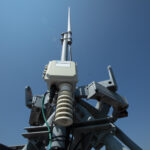Through its recent acquisition of IoT firm Nestwave, NextNav can now combine its highly synchronized TerraPoiNT GPS backup system with Nestwave’s existing terrestrial LTE/5G signals to create near nationwide resilient PNT capabilities—lowering deployment costs by an estimated 75%, or more than $250 million, and allowing the company to scale sooner.
NextNav now has the potential to scale TerraPoiNT in the next 12 to 18 months, rather than the initial 2024/2025 timeframe, NextNav Co-Founder and CEO Ganesh Pattabiraman said. Leveraging Nestwave’s technology and ambient LTE/5G waveform allows NextNav to “gain significant spectral efficiency,” further optimizing the use of its 900MHz spectrum asset. This not only accelerates the availability of resilient PNT, it also opens up capacity for other data-oriented services, including the handset and device ecosystem.
“The positive of the LTE signals is there’s a large presence for it worldwide and the device ecosystem and the chipset ecosystem is large and broad, so that was the big attraction,” Pattabiraman said, noting the acquisition gives NextNav the opportunity to scale both domestically and internationally. “On the flip side, their timing signals are not as pristine as ours. We are down to nano seconds of sync. We recognized that, by combining the two systems, we’d be able to really get to a much higher degree of performance and scale that we both wouldn’t have gotten to on our own.”
The next step is to develop the combined systems and conduct demonstrations and trials, Pattabiraman said, with the focus on seeing “how much performance we can squeeze out of the combined system.” They’ll also begin working with the device and chipset ecosystems to develop capabilities on the appropriate platforms.
The combined system is expected to deliver full PNT capabilities, just as TerraPoiNT does on its own, Pattabiraman said, and will continue to be relied on for applications in the automotive and aviation spaces. Other applications in critical infrastructure, for example, also will emerge, particularly in remote areas.
“Think of an electrical substation in a remote part of the country that needs resilient PNT in addition to what they have today,” Pattabiraman said. “Before, that market was difficult to penetrate because it’s not cost effective to deploy a system. Now, by combining LTE and TerraPoiNT, we believe we can support those types of markets.”
Ultimately, the acquisition will make resilient PNT available to more end users who need it.
“One of the biggest challenges with resilient PNT is the issue of jamming and spoofing, and I think the notion of having a source of timing and positioning information that’s independent of GPS is where the federal government and everybody’s interest is,” Pattabiraman said. “So I think this combination allows us to provide a platform that delivers on resilient PNT on a far more nationwide basis and at a significantly lower cost than if we had to deploy transmitters in every nook and cranny in the country. That’s an expensive proposition that’s not readily available to the marketplace.”
NextNav acquired Nestwave for an enterprise value of $18.0 million with a gross consideration value of $19.3 million, consisting of $4.3 million in cash and $15.0 million in NextNav common stock. The transaction closed on October 31.






